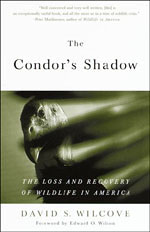“The last quarter of the 19th century and the beginning of the 20th has been called the most destructive period in the history of American wildlife,” writes David Wilcove, senior ecologist with Environmental Defense, in his perspicacious book, The Condor’s Shadow. But he makes the case that the fin de siècle era has a daunting rival in our current age, thanks to the booming economy and rising human population in the U.S. “At stake this time is a far greater number of species, facing a more diverse and powerful set of threats,” Wilcove warns.

The Condor’s Shadow:
The Loss and Recovery
of Wildlife in America
By David S. Wilcove
Bantam Doubleday Dell,
2000, 368 pages
Prospects for America’s native flora and fauna are not good. Approximately 16 percent of species in the U.S. are in “immediate danger of extinction.” Thirty-three percent of the animals and plants on the Endangered Species List are declining. “We are running up against a hefty stewardship bill with little thought as to how we shall pay for it,” Wilcove writes. “And pay it we must, for not to do so would defeat the purpose behind laws like the Endangered Species Act and our investment in our national wildlife refuges and national parks.”
Wilcove takes us on an eloquent tour of American ecosystems. He details the historical cutting and regrowth of Eastern forests and the subsequently altered wildlife populations. What we see as woods today, Wilcove explains, may not provide the habitat required by native species. “Nowhere is this more apparent,” he writes, “than in the southeastern United States, where one of the largest and most distinctive forest ecosystems in North America, the longleaf pine ecosystem, has been all but obliterated.” Though millions of acres of trees stand in pine plantations throughout the region, they do not constitute the mature ecosystems that sustain healthy wildlife populations, vivid illustration of “the difference between reforestation and restoration.”
Wilcove shows how land-use patterns in the West reflect the bitter competition between those who favor exploitation of natural resources and “those who argue that there is no better use of the land than wilderness itself.” Even as this war over land use escalates, “the actual battlefield shrinks in size, diminished by each clearcut and each mile of road punched into the remaining wilderness; consequently the stakes get higher and the disputes become more rancorous.”

Spotted owl threatened by logging
in the Pacific Northwest.
Photo: USFWS.
He deftly details other threats to wildlife with carefully selected examples from every region of the country, showing how the American pursuit of industrial-scale development has systematically upset the natural balance of the continent’s ecosystems, consistently damaging wildlife. Cases in point: the agricultural conversion of the Great Plains, prairies, and grasslands; and the damming, diversion, and pollution of American waterways and coastlines. When discussing global warming and invasive species, Wilcove shows how the problems we’ve created reach well beyond national borders.
Fundamental to The Condor’s Shadow is Wilcove’s passion for wildlife and wilderness protection. Despite the near certainty of a continuing loss of native species, Wilcove’s hard-hitting assessment is not without hope. His understanding of the evolving nature of ecological relationships allows that if Americans make significant changes in how we use the landscape — a big “if” — we may possibly bring the continent’s wildlife back from the brink.


